If you live in Colorado, mapping out the perfect garden can be a challenge due to the temperature and elevation variations. The good news is that there are plenty of plants that can withstand the varied climate of the centennial state. In this article, we examine our favorite perennial plants to put down in your garden if you live in the great state of Colorado.
By Jason White
Adriatic Bellflower

Scientific Name: Campanula garganica
- Plant Type: Pretty Perennial
- Geographic Origin: Southern Europe
- Plant Size: 2 to 4 inches tall
- Sun Exposure: Partial shade to full sun
- Plant Zone: 4 to 7
Adriatic Bellflowers form a sea of starry flowers all summer. It is an exceptional selection for tucking into wall crevices for a cottage garden. This flower comes in purple, hues of pink and white but essentially lavender or light blue perennial blooms.
This perennial flourishes throughout the summer and into fall and spreads 6 inches to 3 feet. It adapts perfectly to well-drained chalk, loam, and sand soil. It’s low maintenance, hardy, and will typically come back each year, even after a little neglect.
Ashy Sunflower
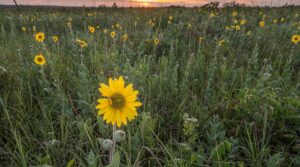
Scientific Name:Helianthus mollis Lam.
- Plant Type: Perennial
- Geographic Origin: North America
- Plant Size: 2 to 6 feet tall
- Sun Exposure: Light shade to full sun
- Plant Zone: 4 to 9
The Ashy sunflower will straighten out and expand into the ground, enveloping a mass of plants with age. They spread two to three inches and have soft, gray-green foliage. Their bright yellow perennial blooms are synonymous with summertime sun.
When planting this, consider giving it considerable room for space. The flowers of this native are superb for attracting bees and butterflies.
When fully developed, the plant thrives exceptionally well in poor soil and withstands slight drought tolerance. Ashy flower prefers full sun and adapts well on average to moderately moist, well-drained soils.
Asters
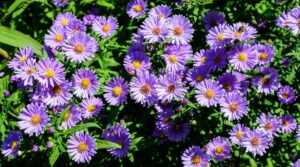
Scientific Name: Aster amellus
- Plant Type: Perennial
- Geographic Origin: Eastern U.S
- Plant Size: 1 to 6 feet tall
- Sun Exposure: Partial shade to full sun
- Plant Zone: 3 to 8
Asters have picturesque daisy-shaped flowers that flourish when numerous summers gradually grow faint and lose their beauty. Asters are easy to grow, and are a favorite amongst gardeners both as a perennial flower, and annual in hotter climates.
The plants brighten up the garden in late summer and Autumn, offering essential late-season nectar for pollinators. Their star-shaped flower heads possess multiple colors, ranging from purple to white to blue.
Asters are highly flexible and bloom in full sun. Some varieties will tolerate part shade but will have minimal flowers. They are well adapted to moist, well-drained, and loamy soil.
Bandwidth Maiden Grass
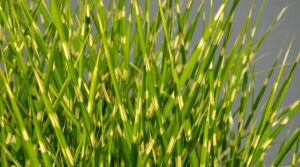
Scientific Name: Miscanthus sinensis
- Plant Type: Perennial
- Geographic Origin: Eastern Asia
- Plant Size: 2 to 3 feet tall
- Sun Exposure: Partial shade to full sun
- Plant Zone: 5 to 9
This flexible dwarf maiden grass with rust-resistant, dazzling yellow and green striped foliage will make your small garden eye-popping.
This long-lasting, intrinsically narrow, upright grass is an excellent accent for large-scale landscapes. While maiden grass tends to spread quickly and sometimes uncontrollably, Bandwidth is not highly productive and does not reseed itself anywhere.
Conspicuous foliage clusters are filled with airy golden brown plumes towards the end of summer and persist into winter. It requires sufficient water, and therefore, it is incredibly crucial to water it regularly – preferably weekly or after a few days.
Bluestar

Scientific Name: Amsonia tabernaemontana
- Plant Type: Perennial
- Geographic Origin: North America
- Plant Size: 2 to 3 feet tall
- Sun Exposure: partial shade to full sun
- Plant Zone: 3 to 11
The plant got its name due to its soft blue, star-like flowers. Although its flowers are small, they flourish in feathery clumps and put on a gorgeous show for a few weeks. Bluestar flowers are among the most authentic blues you will come across in flower colors.
Most various types of Bluestars will spread two to three inches. However, the different sizes that they can grow up to will depend on the variety you grow and the environment. They do exceptionally well in sand, chalk, clay, and loam soil.
Chocolate Flower

Scientific Name: Berlandiera lyrata
- Plant Type: Perennial
- Geographic Origin: Southern United States, Mexico
- Plant Size: 1 to 2 feet tall
- Sun Exposure: Part shade to full sun
- Plant Zone: 4 to 10
Chocolate flower, also known as Lyre-leaf green eyes, is a velvety-leaved perennial. It is amassed, rough, gray-green foliage with a chocolate scent.
In most cases, a leafy plant has numerous short branches at the base and longer, inclining branches finishing in leafless stalks. The upper part has flower heads which consist of yellow rays encompassing a maroon central disk.
The many daisy-like flourishes are two inches wide with yellow rays and a maroon center. The plant thrives in moist soil.
Coral Bells
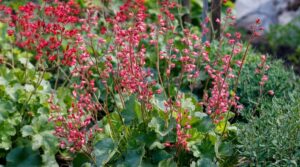
Scientific Name: Heuchera
- Plant type: Herbaceous Perennial
- Geographic Origin: North America
- Plant Size: 8 to 18 feet tall
- Sun Exposure: Partial shade to full sun
- Plant Zone: 4 to 8
Coral bell is a flexible perennial with gorgeous foliage and bell-shaped flowers. Also referred to as Heuchera, they provide a collection of colors and forms multi-seasonal interest and long flourish time. You can grow them in a shade garden or pots as a gardener.
They can persevere under a broad range of light conditions, infertile soil, heat, cold, humidity, and drought. Coral bells produce flowers in hues of coral, red, white, or punk and are alluring to butterflies and hummingbirds.
They are exceptionally adapted to rich, well-draining soil but can endure clay or rocky soils and salt. However, if you are in Colorado, where the soil is heavy clay, you can change it to enhance the drainage before planting your new corals’ bells.
Dianthus Kahori ‘Scarlet’

Scientific Name: Kahori scarlet
- Plant type: Herbaceous Perennial
- Geographic Origin: Europe and Asia
- Plant Size: 0.50 to 1.00 feet tall
- Sun Exposure: Full sun
- Plant Zone: 3 to 9
In spring, this perennial gives rise to abundant dazzling magenta flowers with white centers. It forms grass-like foliage and exhibits remarkable hardiness, never dying out in the middle of the winter.
Therefore, it thrives in a rock garden or a container. It creates a gorgeous ground cover or edging plant for a passageway.
Echinacea ‘Cheyenne Spirit’
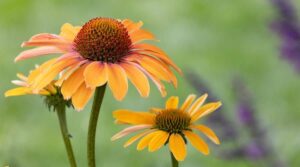
Scientific Name: Echinacea angustifolia
- Plant Type: Perennial
- Geographic Origin: Eastern and North America
- Plant Size: 3 to 4 feet tall
- Sun Exposure: Partial shade to full sun
- Plant Zone: 4 to 8
This perennial flower occurs in numerous colors and varieties that wear a picturesque show every year, from late spring to fall. From Colorado’s high altitude to massive temperature changes and intense hailstorms, these robust flowers can withstand most of the extreme weather found in Colorado.
However, they need a cold, moist period during their germination. The flower is drought resistant and can thrive in clay, loam, or sandy soil.
Geranium ‘Rozanne’
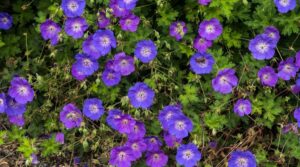
Scientific Name: Geranium ‘gerwat’ Rozanne
- Plant Type: Perennial
- Geographic Origin: South Africa
- Plant Size: 1 to 2 feet tall
- Sun Exposure: Partial sun to full sun
- Plant Zone: 5 to 8
Geranium is highly conspicuous due to its striking violet-blue flowers that combine perfectly with whatever is planted nearby. Geraniums are perennial favorites by many gardeners, but are often grown as annual flowers in hotter climates.
The plant has a habit of spreading out over a sizable area irregularly. Also, the stems have a disorganized way of developing and navigating in and around neighboring plants. However, it supports its numerous flowers high above the foliage.
Geranium will flourish the entire growing season, but it may partially stop flowering mid-season to re-energize. It flourishes in the spring all the way to the summer into immense petaled violet-blue flowers.
It is not susceptible to insects or diseases and can be cut back to refresh, shape, or facilitate more blooms.
Source: https://www.allaboutgardening.com/
